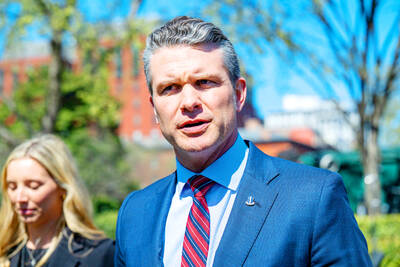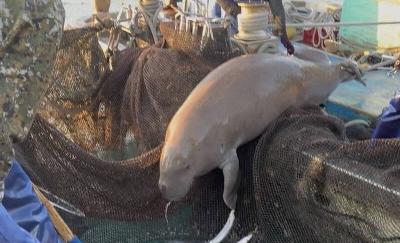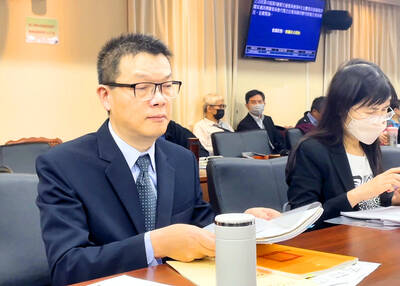Taiwan’s air defense problems might be the most “difficult in the world,” according to a report from the US think tank RAND Corp.
“Taiwan has gone from having a qualitative advantage over the PLA [People’s Liberation Army] in the air, to its current situation, which we assess to be grim indeed,” the 172-page report said.
Titled Air Defense Options for Taiwan and written by Michael Lostumbo, David Frelinger, James Williams and Barry Wilson, the report recommends gutting the fighter plane fleet and spending the savings on surface-to-air missiles (SAM).
Funded by the US Department of Defense, the report could affect future White House decisions on what weapon systems to sell to Taiwan.
“If a major conflict were initiated, China now has the capability to destroy all of Taiwan’s aircraft at their bases, except those that can be hidden in Taiwan’s two mountain shelters,” the report said.
“Taiwan needs to rethink how it can accomplish its air defense goals without heavy reliance on its fight aircraft,” it added.
The report said that Taiwan should use surface-to-air missiles against aircraft and incoming cruise missiles — and improve the survivability of launchers by constantly moving them around.
It said radar is the Achilles’ heel of SAMs, because they need radar to identify, track and attack air threats.
“But an emitting radar is like a bright neon sign and will quickly draw the attention of attack systems,” the report said.
According to the think tank, increasing SAM survivability is a vital component of Taiwan’s future air defense strategies.
In a future conflict, Taiwan would get more from its Patriot and Tien Kung-3 (TK3, “Sky Bow”) SAMs if it preserves them initially by not using them to defend fixed assets, and keeps them concealed until they can be used against landing forces.
RAND estimated that Taipei would spend US$22 billion in the next 20 years on the fighter aircraft currently in its fleet with no changes and another US$3.3 billion to retrofit its F-16 fleet.
“Taiwan is, unfortunately, situated very near a country that continues to make military threats and has invested extensively in a wide range of capabilities that will make it very difficult for Taiwan to fly fighter aircraft in combat,” the report said.
“Although it might be painful for leaders in Taiwan to think of a major divestment of its fighter force, the expectations about the efficacy of that force need to be curtailed,” it added.
RAND recommended that Taiwan spend most of its defense budget not on fighters, but on a SAM force that would keep the airspace above the nation clear to allow other critical military operations.
It said that the SAM force should be increased with a shorter-range system that could provide a more cost-effective layered air defense.
The combination of a short-range interceptor, such as a ground-launched AIM-9X Sidewinder, and a longer-range ground-launched AIM-120 would make a “formidable defense” when used with the existing Patriot/TK-3 defenses.
A force of 21 air defense platoons armed with 1,600 to 2,100 AIM-120 missiles would cost between US$8.1 billion and US$9.2 billion, and would protect large areas of the nation, the report said.
RAND said that, in addition, Taipei could buy five to 12 new batteries of Patriot/TK-3 systems and 300 PAC-3 missiles at a cost of about US$10.6 billion.
The report said that, to afford such missiles, Taiwan would need to give up its F-CK (Indigenous Defense Fighter) and Mirages and reduce its F-16 force.
In an independent analysis of the RAND report, Defense News said that political forces in Taipei and issues regarding pride and morale within the air force made the reduction or elimination of Taiwan’s fighter aircraft fleet unlikely.
Richard Fisher, an Asian military affairs expert at the International Assessment and Strategy Center, told the Taipei Times that RAND’s focus on the air defense challenge alone risks missing a much larger picture.
“The basic threat Taiwan faces into the 2020s is one of actual air-sea invasion, for which destroying Taiwan’s air defenses is but one part of a much more complex campaign,” Fisher said.
He said it was “too early” to write off the fighters.
Fisher said Raytheon had just been selected to develop a Small Advanced Capability Missile (SACM) air-to-air missile (AAM). This could result in Taiwan’s F-16s being able to carry up to 22 medium-range AAMs.
“In that case, one F-16 might threaten nearly a regiment or a whole unit of PLA fighters,” Fisher said. “If the SACM proves successful, you might want to keep your F-16s and not trade them for more SAMs,” he added.
“The basic strategic challenge for Taiwan is to obtain exponential leaps in weapon capability for the minimal increase in defense expenditure. Taiwan will have to spend much more on defense to deter Chinese attack, but it can gain much more capability by retaining or investing in new multi-role weapons that can provide air defense, sea defense and ground attack,” Fisher said.

‘DENIAL DEFENSE’: The US would increase its military presence with uncrewed ships, and submarines, while boosting defense in the Indo-Pacific, a Pete Hegseth memo said The US is reorienting its military strategy to focus primarily on deterring a potential Chinese invasion of Taiwan, a memo signed by US Secretary of Defense Pete Hegseth showed. The memo also called on Taiwan to increase its defense spending. The document, known as the “Interim National Defense Strategic Guidance,” was distributed this month and detailed the national defense plans of US President Donald Trump’s administration, an article in the Washington Post said on Saturday. It outlines how the US can prepare for a potential war with China and defend itself from threats in the “near abroad,” including Greenland and the Panama

A wild live dugong was found in Taiwan for the first time in 88 years, after it was accidentally caught by a fisher’s net on Tuesday in Yilan County’s Fenniaolin (粉鳥林). This is the first sighting of the species in Taiwan since 1937, having already been considered “extinct” in the country and considered as “vulnerable” by the International Union for Conservation of Nature. A fisher surnamed Chen (陳) went to Fenniaolin to collect the fish in his netting, but instead caught a 3m long, 500kg dugong. The fisher released the animal back into the wild, not realizing it was an endangered species at

The High Prosecutors’ Office yesterday withdrew an appeal against the acquittal of a former bank manager 22 years after his death, marking Taiwan’s first instance of prosecutors rendering posthumous justice to a wrongfully convicted defendant. Chu Ching-en (諸慶恩) — formerly a manager at the Taipei branch of BNP Paribas — was in 1999 accused by Weng Mao-chung (翁茂鍾), then-president of Chia Her Industrial Co, of forging a request for a fixed deposit of US$10 million by I-Hwa Industrial Co, a subsidiary of Chia Her, which was used as collateral. Chu was ruled not guilty in the first trial, but was found guilty

DEADLOCK: As the commission is unable to forum a quorum to review license renewal applications, the channel operators are not at fault and can air past their license date The National Communications Commission (NCC) yesterday said that the Public Television Service (PTS) and 36 other television and radio broadcasters could continue airing, despite the commission’s inability to meet a quorum to review their license renewal applications. The licenses of PTS and the other channels are set to expire between this month and June. The National Communications Commission Organization Act (國家通訊傳播委員會組織法) stipulates that the commission must meet the mandated quorum of four to hold a valid meeting. The seven-member commission currently has only three commissioners. “We have informed the channel operators of the progress we have made in reviewing their license renewal applications, and